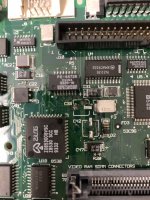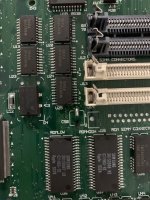NathanHill
Active member
Hey y'all,
Love the resources here - but I don't see a concise recapping thread or guide. If there is and search hasn't helped, let me know.
My father passed recently. He was a lifelong Mac/Apple enthusiast and over the years had piled together a sizable set of Apple II and vintage Mac gear. My brother and I went up and picked a few items for us to tinker with and will probably be looking to part with many other items (6-10 SE FDHDs, Classics, LCs, LC IIs, LC III, a couple of Quadras, plenty of Apple IIe gear, a Next machine, and on and on). So, look for that in the future.
I am working on recapping a Color Classic and an SE/30. I also have a Quadra 610 and Mac Iici board. I am new to this process, and while the Youtube videos make it look easy, it's hardly easy at all in person. Pulling the caps off the IIci board was somewhat okay, but it has battery damage and may be out of commission anyway. It's my practice board for now. I've noticed several of the areas are still not smooth, making the next step difficult.
I am struggling with how to replace the capacitors. Do they need to be completely level on the board? Does the solder serve just to tie them to the board or to keep the circuit flowing? Basically, it's hard to place the replacement capacitor in place and then not move it with even a tiny nudge of the soldering iron. Do you all tape them in place and then solder them? Or is there some helpful method?
Love the resources here - but I don't see a concise recapping thread or guide. If there is and search hasn't helped, let me know.
My father passed recently. He was a lifelong Mac/Apple enthusiast and over the years had piled together a sizable set of Apple II and vintage Mac gear. My brother and I went up and picked a few items for us to tinker with and will probably be looking to part with many other items (6-10 SE FDHDs, Classics, LCs, LC IIs, LC III, a couple of Quadras, plenty of Apple IIe gear, a Next machine, and on and on). So, look for that in the future.
I am working on recapping a Color Classic and an SE/30. I also have a Quadra 610 and Mac Iici board. I am new to this process, and while the Youtube videos make it look easy, it's hardly easy at all in person. Pulling the caps off the IIci board was somewhat okay, but it has battery damage and may be out of commission anyway. It's my practice board for now. I've noticed several of the areas are still not smooth, making the next step difficult.
I am struggling with how to replace the capacitors. Do they need to be completely level on the board? Does the solder serve just to tie them to the board or to keep the circuit flowing? Basically, it's hard to place the replacement capacitor in place and then not move it with even a tiny nudge of the soldering iron. Do you all tape them in place and then solder them? Or is there some helpful method?


